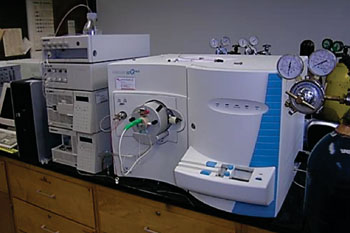Blood Test Developed to Diagnose Concussion
By LabMedica International staff writers
Posted on 25 Nov 2016
Diagnosis of a clinically significant concussion, or a mild traumatic brain injury, can be difficult as it currently relies on a combination of patient symptom assessment and clinician judgment.Posted on 25 Nov 2016
Equally problematic are the decisions to stop play or activities, or when patients who have suffered a concussion can safely return to normal activities without risking further injury. A blood test has been developed that can now accurately diagnose a concussion using a form of blood profiling known as metabolomics.

Image: Liquid chromatography tandem mass spectrometry instrumentation (Photo courtesy of Western University).
A multidisciplinary team of scientists at Western University (London, Canada) obtained plasma from male hockey players, 12 who were concussed and 17 non-concussed athletes, and assayed for 174 metabolites with proton nuclear magnetic resonance and direct injection liquid chromatography tandem mass spectrometry. Data were analyzed with multivariate statistical analysis and machine learning. For the relatively inexpensive test, blood is drawn from an individual that may have suffered a concussion as the result of a sudden blow to the head (or from transmitted forces from a sudden blow to the body) within 72 hours of the incident.
The scientists reported that the estimated time from concussion occurrence to blood draw at the first clinic visit was 2.3 ± 0.7 days. Using principal component analysis, the leading 10 components, each containing nine metabolites, were shown to account for 82 % of the variance between cohorts, and relied heavily on changes in glycerophospholipids. The number of metabolites required to achieve the 92 % diagnostic accuracy was minimized from 174 to as few as 17 metabolites. Receiver operating characteristic analyses generated an area under the curve of 0.91, indicating excellent concussion diagnostic potential.
Mark Daley, PhD, a professor and co-investigator of the study, said, “We looked at all of these metabolites in concussed male adolescent patients and in non-concussed male adolescent patients and it turns out that the spectrum is really different. There is no one metabolite that we can put a finger on but when we looked at all of them, those profiles are different enough that we could easily distinguish concussed patients from non-concussed. In fact, with fine tuning we can now look at sets of as few as 20 to 40 specific metabolites and maintain the diagnostic accuracy level of the test over 90%.”
Related Links:
Western University














